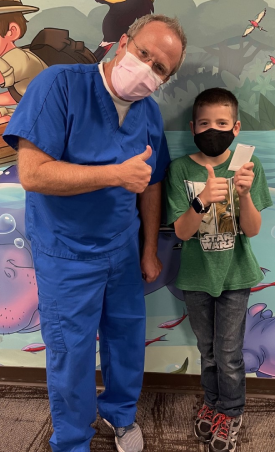One of the most important questions new parents ask is when to start brushing baby teeth and how to properly care for their infant’s developing oral health. At Great Falls Pediatric Dentistry & Orthodontics, our certified pediatric specialists guide families in Great Falls and Havre, Montana, through the essential steps of establishing proper oral hygiene routines from birth. Understanding the correct timeline and techniques for infant oral care sets the foundation for a lifetime of healthy teeth and positive dental experiences.
Starting oral care early—even before the first tooth appears—is crucial for preventing tooth decay, establishing healthy habits, and preparing your baby for proper dental hygiene throughout their life. The transition from gum care to tooth brushing requires specific knowledge about timing, techniques, and appropriate products that support your baby’s developing oral health needs.
Pre-Tooth Oral Care: Birth to 6 Months
Proper oral hygiene begins before your baby’s first tooth appears. During the first six months of life, establishing cleaning routines and maintaining oral health creates the optimal environment for healthy tooth eruption and helps prevent bacterial buildup that could affect emerging teeth.
Cleaning Gums Before Teeth Emerge
Begin cleaning your baby’s gums within the first few days after birth. Use a soft, damp washcloth or gauze pad to gently wipe the gums, tongue, and inside of the mouth after feedings. This process removes milk residue and bacteria that can accumulate even before teeth are present.
The American Academy of Pediatric Dentistry recommends this early cleaning routine because it establishes oral hygiene habits while preventing bacterial overgrowth that could affect the health of emerging teeth. Even though no teeth are visible, harmful bacteria can still accumulate in the mouth and create conditions that lead to problems once teeth appear.
This early care also helps babies become accustomed to having their mouths cleaned, making the transition to tooth brushing smoother and less stressful when teeth begin erupting.
Establishing Feeding Practices That Support Oral Health
During the pre-tooth stage, feeding practices significantly impact future oral health. Whether breastfeeding or bottle-feeding, avoid putting babies to sleep with bottles containing anything other than water, as prolonged exposure to milk or formula can create conditions favorable for tooth decay once teeth emerge.
Begin establishing feeding schedules that limit prolonged exposure to sugary liquids. This early prevention strategy becomes increasingly important as teeth begin to appear and are susceptible to early childhood caries.
When Baby Teeth Begin to Emerge: 4-7 Months
Most babies begin teething between 4-7 months of age, though timing can vary significantly among individual children. The first teeth to appear are typically the lower central incisors (bottom front teeth), followed by the upper central incisors. This is when actual tooth brushing should begin.
Transitioning from Gum Cleaning to Tooth Brushing
As soon as the first tooth appears, transition from gum wiping to gentle tooth brushing. Use a soft-bristled infant toothbrush specifically designed for babies, along with a tiny amount of fluoride toothpaste—about the size of a grain of rice.
This transition marks a crucial milestone in your baby’s oral health care routine. The emergence of teeth creates new surfaces where bacteria can accumulate and produce acids that cause tooth decay. Proper brushing removes these bacteria and helps establish the oral hygiene habits that will protect your child’s teeth throughout their life.
Our pediatric dentists at Great Falls Pediatric Dentistry emphasize that this early brushing is just as important as brushing permanent teeth, despite the temporary nature of baby teeth.
Choosing Appropriate Brushing Tools
Select a toothbrush with soft bristles and a small head that fits comfortably in your baby’s mouth. The handle should be large enough for you to grip securely while providing gentle, controlled brushing motions.
Replace infant toothbrushes frequently, typically every 3-4 months or sooner if bristles become frayed. Babies often chew on their toothbrushes, which can wear down bristles more quickly than normal brushing.
Proper Brushing Techniques for Baby Teeth
Effective brushing techniques for baby teeth differ from adult brushing methods due to the small size of infant mouths, limited tooth surfaces, and the need for complete parental control during the process.
Positioning and Approach
Hold your baby securely in your lap or lay them on a changing table where you can easily see into their mouth. Good lighting is essential for thorough cleaning and monitoring of oral health. Some parents find it helpful to sit on the floor with the baby’s head in their lap, allowing for better control and visibility.
Use gentle, circular motions to clean all tooth surfaces, including the fronts, backs, and chewing surfaces as more teeth emerge. Pay special attention to the gum line where bacteria tend to accumulate.
Brushing Duration and Frequency
Brush your baby’s teeth twice daily—once in the morning and once before bedtime. Each brushing session should last about two minutes, though this may need to be built up gradually as babies adjust to the routine.
Consistency is more important than duration in the beginning. It’s better to have shorter, positive brushing experiences than to struggle through longer sessions that create negative associations with oral hygiene.
Fluoride Toothpaste Guidelines
Use fluoride toothpaste from the time the first tooth appears, but limit the amount to a tiny smear about the size of a grain of rice. This minimal amount provides cavity protection while minimizing fluoride ingestion concerns.
The American Dental Association confirms that this small amount of fluoride toothpaste is safe and effective for babies, providing important protection against tooth decay during these vulnerable early months.
Age-Specific Brushing Milestones
As babies grow and develop more teeth, brushing techniques and expectations evolve to match their developmental capabilities and changing oral health needs.
6-12 Months: Foundation Building
During this period, focus on establishing consistent routines rather than perfect technique. Babies are learning to tolerate having their mouths handled and becoming familiar with the sensations of tooth brushing.
Most babies will have 2-8 teeth by their first birthday, requiring more comprehensive brushing as additional teeth emerge. Continue with the grain-of-rice amount of fluoride toothpaste and gentle, thorough cleaning of all tooth surfaces.
This is also when you should schedule your baby’s first dental visit to establish professional care and receive personalized guidance on home oral hygiene techniques.
12-24 Months: Skill Development
Toddlers in this age range typically have 8-16 teeth and may begin showing interest in holding their own toothbrush. While they lack the fine motor skills for effective brushing, allowing them to “help” builds positive associations with oral hygiene.
Continue providing complete brushing assistance while encouraging your toddler’s participation. This might involve letting them hold the toothbrush handle while you guide the brushing motions or allowing them to brush first before you follow up with thorough cleaning.
Increase the fluoride toothpaste amount to about the size of a pea once your child can reliably spit out toothpaste, typically around age 2-3.
2-3 Years: Independence Development
Two-year-olds often want to brush their own teeth but still require significant assistance and supervision. This is an excellent time to begin teaching proper brushing techniques while maintaining primary responsibility for thorough cleaning.
Most children have all 20 primary teeth by age 3, requiring comprehensive brushing of all tooth surfaces. Establish morning and evening routines that include brushing, and begin introducing flossing when teeth touch each other.
Common Challenges and Solutions
Many parents encounter specific challenges when establishing tooth brushing routines with babies and toddlers. Understanding these common issues and effective solutions helps maintain consistent oral hygiene despite difficulties.
Resistance to Brushing
Babies and toddlers often resist having their teeth brushed, particularly during the adjustment period when they’re becoming familiar with new sensations and routines. This resistance is normal and typically decreases with consistency and positive approaches.
Make brushing fun by singing songs, counting teeth, or playing games during the process. Some parents find success with special brushing songs or letting children choose between different toothbrush colors or flavors.
If resistance persists, try different positions, times of day, or approaches until you find what works best for your child. The key is maintaining the routine while making adjustments to improve cooperation.
Gagging or Discomfort
Some babies gag easily when toothbrushes touch certain areas of their mouths. Start with very gentle pressure and gradually increase as your baby becomes more comfortable with the sensations.
Use toothbrushes specifically designed for infants, which have softer bristles and smaller heads that are less likely to trigger gag reflexes. If gagging continues to be a problem, consult with our pediatric specialists for additional guidance.
Teething Interference
Teething can make teeth and gums sensitive, sometimes interfering with regular brushing routines. During active teething periods, use extra-soft toothbrushes and very gentle pressure while maintaining the cleaning routine.
Cold washcloths or teething toys before brushing can help numb sore gums and make brushing more comfortable. Never skip brushing entirely during teething—adjust your technique instead.
Professional Guidance and Support
Regular professional care supports home oral hygiene efforts and provides ongoing guidance as your child’s needs evolve. Establishing a dental home early ensures continuity of care and professional support throughout your child’s development.
First Dental Visit Timing
Schedule your baby’s first dental visit by their first birthday or within six months of the first tooth appearing, whichever comes first. This early visit allows our team at Great Falls and Havre locations to assess your baby’s oral development and provide personalized home care guidance.
Early dental visits focus on education rather than treatment, helping parents learn proper brushing techniques, understand their child’s specific needs, and identify any potential concerns before they become problems.
Ongoing Professional Support
Regular checkups and cleanings every six months provide opportunities for professional monitoring, preventive treatments like fluoride applications, and continued education as your child’s oral hygiene needs evolve.
Our team provides demonstrations of proper brushing techniques, recommends appropriate products for different developmental stages, and addresses any concerns or questions that arise as your child grows.
Nutrition and Its Impact on Baby Teeth
Diet plays a crucial role in maintaining healthy baby teeth, and understanding the relationship between nutrition and oral health helps parents make informed feeding decisions.
Feeding Practices That Protect Teeth
Avoid putting babies to bed with bottles containing milk, formula, or juice, as prolonged exposure to sugary liquids creates ideal conditions for tooth decay. If comfort feeding is necessary at bedtime, use only water in bottles.
Limit frequent snacking and sipping throughout the day, as constant exposure to food and beverages creates ongoing acid attacks on tooth enamel. Instead, offer meals and snacks at specific times, allowing teeth to recover between eating periods.
Introducing Solid Foods
As babies begin eating solid foods, choose options that support oral health while meeting nutritional needs. Fresh fruits and vegetables provide essential nutrients while requiring chewing that stimulates healthy gum tissue.
Avoid sticky, sugary snacks that cling to teeth and provide prolonged exposure to decay-causing bacteria. When sweet treats are offered, provide them during mealtime rather than as standalone snacks.
Building Lifelong Healthy Habits
The oral hygiene routines established during infancy create the foundation for lifelong healthy habits. Understanding how early experiences shape future attitudes toward dental care helps parents prioritize consistent, positive oral hygiene practices.
Creating Positive Associations
Make tooth brushing a positive, enjoyable experience through songs, games, praise, and celebration of cooperation. Children who associate oral hygiene with positive feelings are more likely to maintain good habits throughout their lives.
Avoid using brushing as punishment or expressing frustration during difficult brushing sessions. Instead, remain patient and focus on gradual improvement and consistency.
Family Oral Health Modeling
Children learn by watching their parents, so demonstrating good oral hygiene habits provides powerful modeling for developing children. Let your baby watch you brush your teeth and express enthusiasm about taking care of your smile.
Make oral hygiene a family activity when possible, allowing older siblings to help or participate in younger children’s brushing routines under supervision.
Emergency Situations and Infant Oral Health
Understanding how to handle dental emergencies involving baby teeth helps parents respond appropriately to unexpected situations while maintaining overall oral health routines.
When to Seek Professional Care
Contact our 24/7 emergency services at (406) 205-3586 if your baby experiences dental trauma, persistent pain, swelling, or signs of infection around emerging teeth.
Early intervention for dental problems often leads to simpler, more comfortable treatments and better long-term outcomes for both baby teeth and developing permanent teeth.
Maintaining Routines During Illness
Continue oral hygiene routines even when babies are sick, as illness can increase the risk of oral health problems. Use gentler techniques if necessary, but avoid skipping brushing entirely unless specifically advised by healthcare providers.
Conclusion: Setting the Foundation for Lifelong Oral Health
Starting to brush baby teeth at the right time with proper techniques creates the foundation for a lifetime of healthy smiles. Beginning oral care before teeth emerge and transitioning to proper brushing as soon as the first tooth appears provides optimal protection during these crucial developmental months.
At Great Falls Pediatric Dentistry & Orthodontics, our experienced pediatric team is committed to supporting families through every stage of their child’s oral health journey. From pre-tooth care guidance to establishing effective brushing routines, we provide the professional support and education parents need to help their children develop excellent oral health habits.
Remember that consistency and patience are more important than perfection when establishing oral hygiene routines with babies and toddlers. With the right timing, techniques, and professional support, you can help your child develop the healthy habits that will protect their smile throughout their life.
Don’t wait to begin your baby’s oral health care journey. Contact Great Falls Pediatric Dentistry & Orthodontics today to schedule your infant’s first dental visit and receive personalized guidance on when and how to start brushing your baby’s teeth.
Call (406) 205-3586 to schedule your baby’s first dental visit at our Great Falls or Havre location. Our pediatric specialists will provide expert guidance on proper infant oral hygiene techniques and timing.



